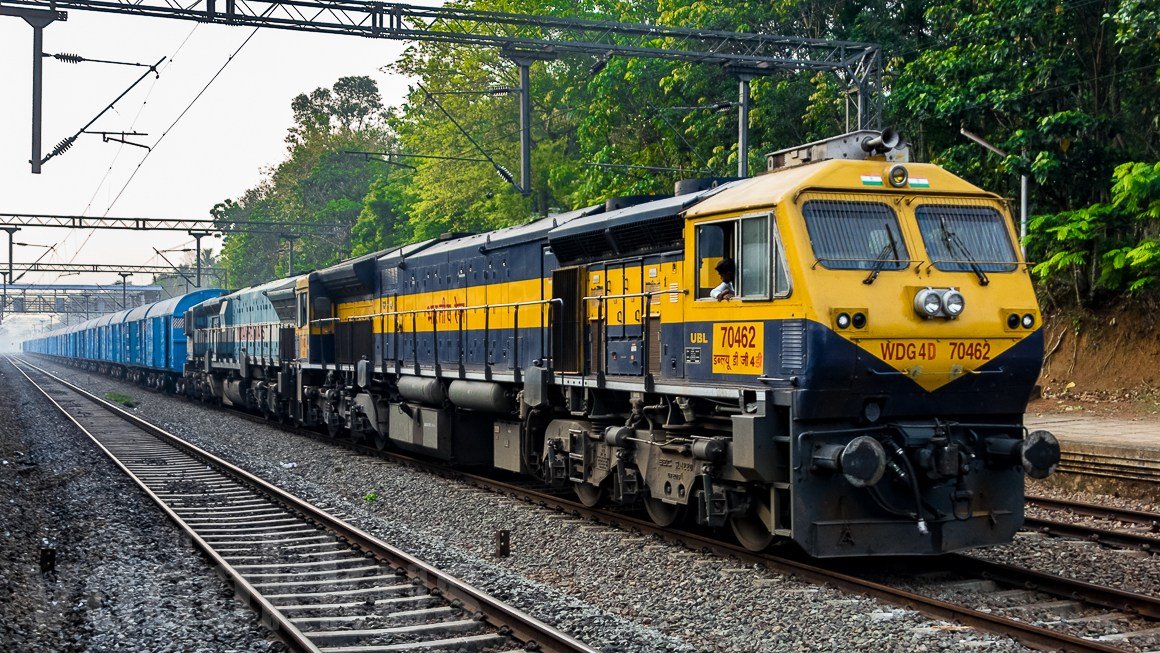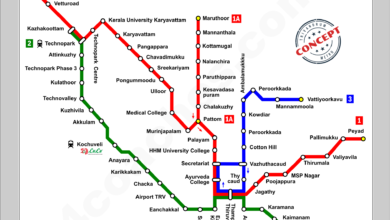What Derailed Railway Infrastructure in Kerala? Part 1

The state of railway infrastructure and operations in Kerala has devolved into a situation that is beyond pathetic. For the past two years, the quality and levels of railway service in the state have fallen drastically as passengers have been suffering no end with terrible punctuality and horrible trains. It is been a long time since any new, practical trains were introduced or since major trains actually dependably ran on time. And no one is doing anything about it. The condition of the railways in Kerala can aptly be taken as a case study for the problems ailing the railways in India as a whole and how it can be redeemed. As we saw in the last chapter, the primary reason for these state of affairs can be found to be the decades-long neglect in creating basic railway infrastructure in the state. What we need to identify next is to why the state was left behind in infrastructure creation compared to its neighbours. We don’t have to travel far to identify the reasons for this neglect because they are quite apparent. They were mostly deliberate, the product of Indian Railway’s lasting colonial legacy. They are mainly financial and bureaucratic. We will examine the first among these in this chapter.
Kerala Never Gets Enough Money to Fund its Railway Projects
The Indian Railways is a centrally planned monopoly and a closed system, completely isolated and protected from “market forces” of supply and demand as all fares, funds and rents related to the Indian Railways are fully controlled and released by politicians and bureaucrats. The funds for the railway projects are released almost always only as per political considerations and climates and not as per “demands” and “needs”. The release of funds used to happen through the railway budget until 2014, and happens through the union budget today. If you want railway projects to be executed, you need be able to wring the most money out of the railways’ and central government’s kitty through MPs (and not through transportation experts). This can happen only through political will with bureaucratic support, when these two branches work in sync. In short, any region that aspires to get funds released for its projects needs to have a good amount of clout in the central government structure. And this is where Kerala faltered. The state has failed miserably at securing funding for its projects in all the past years, no matter who was running the government both at the centre and in the state. Let us have a look at how much funds Kerala was allocated for railway development projects in the past 11 financial years.
Looking these figures, one can see that they are nothing but a joke. Railway development projects are incredibly capital-intensive undertakings where relatively small projects like road overbridges can cost 50 crores. The funds the state was allocated were never enough for even basic things such as track renewal, forget acquiring land for new projects or even completing line doubling. Even the total amount allocated for all these 11 years, 6634 crores amounts to nothing. For instance, Save the last four years, the state never received more than Rs. 374 crores in total except for 2011-12 (election gimmick). This amount was to be distributed among hundreds of railway projects, big and small, in two divisions. This is why for many, many years, TVC and PGT could not double their lines, create new infrastructure, renew tracks, upgrade facilities or generally do anything at all.
There is no denying that things did actually change in the last four years. Average allocation during the time of the NDA government has jumped to more than 2.5 times over the UPA I and II governments. That apart, nothing much as changed. The current government focuses quite a bit at infrastructure development and hence has shown the same generosity towards all states and despite the higher allocated amount, Kerala is at the bottom of this list too! The absolute amount allocated has gone up, but the way the pie is shared has remained the same. Only Delhi and Himachal were allocated less funds than Kerala. One could argue that being a small state, Kerala can obviously be allocated lesser funds than, say, Tamil Nadu or Uttar Pradesh, which are far bigger in terms of railway network and population. Fair point. In that case, let us talk some other parameters like per-person, per-track kilometre, etc.

It does not matter what parameter you take and how you look at it. Kerala still gets among the lowest fund and infrastructure allocations in the country. It already has the lowest railway track per person ratio and also the lowest funds for railways allocated per person in the country. Kerala saw the third least overall funds allocated, second least amount of funds allocated per person, fourth least amounts of funds allocated per track kilometre and sixth least funds allocated per route kilometre. If you take only large states (more than 3 lakh population), it turns out that Kerala is the most neglected in the country.
Now, “fund allocation” does not mean that an amount is credited in some account to be spent at will. “Allocations” are actually only the sum total of entries (projects) listed in what the railways call the “Pink Book” that will turn real only when projects get executed and contractors approach the railways for payouts. In reality, a lot of these projects never get executed for a number of reasons. These can range from procedural (alignments not finalised or in litigation, officials not appointed, etc) to economic to bureaucratic to political (the bosses simply will order officials to not spend money so it can diverted elsewhere) and so on. The result will be that a sizable chunk of these allocations end up not realised. These are then said to “lapse” and “returned to the railways”. This is what has been happening in Kerala for the past many years. Last year (2017-18) close to 450 crores or around 40% of the allocated amount could not be utilised by Trivandrum and Palakkad divisions for various reasons. There is no transparency and no point of contact to know the status of funds actually allocated and utilised.
Why Does Kerala Get so Little as Funds for Railways?
Politics. Massive levels of political and bureaucratic bias and neglect. At the end of the day, it is the politicians who decide what which people of India should get. Division and allocation of funds in a country like India which does not really have a surplus economy will always be hotly contested and biased as per politically skewed priorities. These include populism, power of might and numbers by favouring favourite constituents and in many cases, depriving unfavored ones. Politicians always tend to allocate funds towards constituencies of consequence for them, like those who for instance can help secure them power, and not towards those really deserving (if people really got what they deserved, the world would’ve been a much better place). We have seen this only way too often how this system has transfigured Indian Railways into an elaborate politico-bureaucratic control system for political dividends using the carrot and stick method. To get funds allocated and improve railway infra in your state, it should either be the home of the railway minister or some other very powerful ruling politicians, or should have disproportionate political influence on the government (large number of MPs who can make a difference in govt formation), or at some other strategically important position for the ruling party. The tragedy is that Kerala never featured in any of those categories, no matter who formed the government.
The argument for the neglect of the state on the national political front is easy to substantiate. No, it does not matter which way the state votes. Kerala, despite all its grandstanding, is a politically inconsequential state. Its meager 20 MPs (3.68%) can never expect to play any decisive role in the corridors of power on a national level, no matter what party they belong to. It is another thing that the 20 MPs always seem to come from one side of the political spectrum and are hence taken for granted by that side (during UPA II, Kerala had eight central ministers but the state got exactly nothing from railways during that time) or ignored by the other. It takes real hard work by Kerala MPs to get anything for their constituencies. As for having clout in the central government, ever since the legendary Panampilli Govinda Menon (1969-1970) who created the Trivandrum division and the Ernakulam-Trivandrum railway line, Kerala has had no railway minister. O. Rajagopal and E. Ahmed have been ministers of state for railways, but they could do nothing to augment railway infrastructure in the state (they did help to start a few new trains, though).
Economics: In India it is railway freight services that earns revenue. Passenger traffic, thanks to unrealistically low pricing, operate perennially in loss and have to be cross-subsidised by freight. Any heavy investment in railway infrastructure is always aimed at freight traffic. The best example is the Dedicated Freight Corridors (DFCs) project. As of January 2018, only 5 years after the first contract was awarded, work for around 40% of the 2822 km have already been completed. It is probably the first time a railway project has been progressing at such rapid pace since British times. And Kerala sees close to no freight traffic. There are hardly any industries warranting regular heavy freight loading, apart from the Kochi Port and the Petroleum industries around Ernakulam. Almost all railway revenues in Kerala come from passenger traffic, (as is majority revenues for Southern Railway). Any large investment in Kerala is hence probably considered bad ROI by the railways.

In the end, it won’t matter which way the state votes, the situation will always be the same. The state will be stuck at the bottom of the table with crumbs thrown at it. Kerala will have to fend for itself as it had been doing for millennia.
The Land Acquisition Question
The bulk of the cost for any railway project will be accounted under land acquisition. Yes, the main reason why projects in Kerala to take so much time to complete is the difficulty in acquiring land. Land acquisition is a touchy and messy topic throughout the nation but it is particularly bad in Kerala. Given highly fragmented landholding patterns featuring evenly distributed small parcels of private land or dwellings, the process of acquiring even a small single parcel of land can take years of negotiation and litigation involving multiple parties. You will not find huge tracts of field and farmland or scrub or wasteland which can quickly be acquired en-masse for cheap. Even in the interiors you will find houses situated closely next to each other. A single acre plot in a village can contain ten houses overall owned by twenty people. And of course, market land prices will obviously be expensive, another reason why people don’t want to give up their land.
Unlike much of the rest of the country, people in Kerala refuse to give up land not because they use it for sustenance (no one cultivates anymore). They consider land to be purely a speculative investment vehicle to be liquidated it at “higher” prices in the future. In fact, land-deals are the second highest direct source of income (yes, income) in Kerala after remittances. Selling land is no longer restricted to meet emergencies or marry off children, but even to finance flashy consumerist cravings like big cars, houses, utilities, foreign trips etc. The point here is that the government is missing a golden opportunity to easily acquire land in Kerala. People hoard land for the very purpose of selling it off, provided they are offered a right price close enough to the market price. And there lies the catch. “Market price”. Land acquisition in Kerala is difficult because the authorities are willing to pay only government-prescribed guidance value, which will be much lower than actual market prices. Fertile semi-urban land in Kerala and arid scrubland in Telangana cannot be priced the same because both lie 5 km from an urban settlement. Would you give away your land that would otherwise fetch 5 lakhs on the market for 1.2 lakhs to the railways? It is another thing that not enough money is allocated to acquire land even at those below-market prices.
There is more. Haggling between state and central governments on land acquisition and other revenue sharing aspects further complicates the matter. Kerala was one of the first state to sign an agreement (MoU) with the railways to set up an independent company to manage railway projects in the state. KSRDC has only ended up only the latest in a long, long list of government corporations that sit around doing nothing. The state government had at first agreed to share cost for the construction of several projects at first only to back out later. Given land acquisition is a unpopular matter, no politician wants to get involved in it, much less sanction funds for it. They don’t take the pain to explain to people how expanding infrastructure will help them in the future. It is risky, blind populism is far more effective to retain electoral seats. Finally, people refuse to part with their land for railway projects because they know construction will take decades, by which time their lands would be worth several times over.
Everyone wants fast trains and wide highways, but only not on their land. This mentality, known as NIMBY-ism (Not In My Back Yard) while is about politics in the USA and other places, is purely about economics in Kerala. If authorities are ready to pay market prices for land, acquisition can happen much smoother and faster than what we see today. However, that will mean enormous amounts of money which they don’t want to spend on Kerala for all the political and economic reasons we have seen. So, now we know where the real matter of the problem lies. The state has meager funds allocated in the first place, which then aren’t even utilised. This apathy almost seems to be like an institutionalised policy these days. However, is paucity of funds is only half the story. The second major reason for why there is no railway infrastructure in Kerala is the railways themselves. Read on.





It’s mostly freight I would say.
Look at Chhattisgarh – only 11 MPs, no central ministers. Yet you should see railway projects there, new and expanding.
The only way I could see if if the zones or divisions are made separate company and the fare is increased. Else a little would be sanctioned and none used except for bare minimum maintenace.